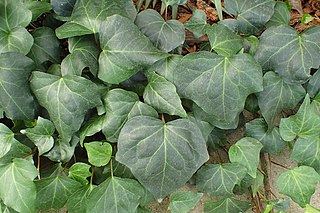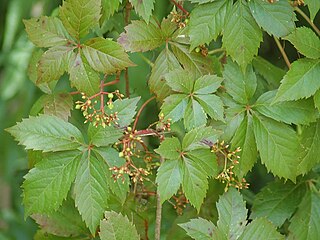
A vine is any plant with a growth habit of trailing or scandent stems, lianas, or runners. The word vine can also refer to such stems or runners themselves, for instance, when used in wicker work.

Senecio is a genus of flowering plants in the daisy family (Asteraceae) that includes ragworts and groundsels.
Ivy without qualifiers usually means plants in the genus Hedera in the family Araliaceae.

Hedera, commonly called ivy, is a genus of 12–15 species of evergreen climbing or ground-creeping woody plants in the family Araliaceae, native to Western Europe, Central Europe, Southern Europe, Macaronesia, northwestern Africa and across central-southern Asia east to Japan and Taiwan. Several species are cultivated as climbing ornamentals, and the name ivy especially denotes common ivy, known in North America as "English ivy", which is frequently planted to clothe brick walls.

Parthenocissus quinquefolia, known as Virginia creeper, Victoria creeper, five-leaved ivy, or five-finger, is a species of flowering vine in the grape family, Vitaceae. It is native to eastern and central North America, from southeastern Canada and the eastern United States west to Manitoba and Utah, and south to eastern Mexico and Guatemala.

Parthenocissus tricuspidata is a flowering plant in the grape family (Vitaceae) native to eastern Asia in Korea, Japan, and northern and eastern China. Although unrelated to true ivy, it is commonly known as Boston ivy, grape ivy, and Japanese ivy, and also as Japanese creeper, and by the name woodbine.

Hedera hibernica, the Atlantic ivy, Boston ivy or Irish ivy, is a species of ivy native to the Atlantic coast of Europe.

Parthenocissus, is a genus of tendril climbing plants in the grape family, Vitaceae. It contains about 12 species native to the Himalaya, eastern Asia and North America. Several are grown for ornamental use, notably P. henryana, P. quinquefolia and P. tricuspidata.
In zoological nomenclature, the specific name is the second part within the scientific name of a species. The first part of the name of a species is the name of the genus or the generic name. The rules and regulations governing the giving of a new species name are explained in the article species description. For example, the scientific name for humans is Homo sapiens, which is the species name, consisting of two names: Homo is the "generic name" and sapiens is the "specific name".
Japanese ivy may refer to:

Hedera helix, the common ivy, English ivy, European ivy, or just ivy, is a species of flowering plant of the ivy genus in the family Araliaceae, native to most of Europe and western Asia. A rampant, clinging evergreen vine, it is a familiar sight in gardens, waste spaces, and wild areas, where it grows on walls, fences, tree trunks, etc. across its native and introduced habitats. As a result of its hardy nature, and its tendency to grow readily without human assistance, ivy attained popularity as an ornamental plant, but escaped plants have become naturalised outside its native range and grow unchecked in myriad wild and cultivated areas. Ivy has considerable cultural significance and symbolism.

Senecio macroglossus, the Natal ivy, marguerite ivy, climbing senecio or wax ivy, is a species of flowering plant in the family Asteraceae, native to southern Africa, from Zimbabwe and Mozambique to eastern South Africa.

Delairea is a genus of flowering plants within the family Asteraceae. Currently, it only features two species: Delairea odorata from Southern Africa, and the recently discovered Delairea aparadensis from Southern Brazil, which is critically endangered. D. odorata formerly belonged to the genus Senecio as Senecio mikanioides.

Delairea odorata is a climber within the family Asteraceae that is native to South Africa. One of the two species in the genus Delairea, it was previously included in the genus Senecio as Senecio mikanioides. It is known as Cape ivy in some parts of the world (US) and German ivy in others. Other names include parlor ivy and Italian ivy.
Groundsel is a common name for several plants and may refer to:
Cape ivy or German ivy or parlor ivy or Italian ivy is probably:

Senecio angulatus, also known as creeping groundsel and Cape ivy, is a succulent flowering plant in the family Asteraceae that is native to South Africa. Cape ivy is a scrambling herb that can become an aggressive weed once established, making it an invasive species. It is grown as an ornamental plant for its satiny foliage and sweet-scented flowers.

Senecio tamoides, also known as Canary creeper, false grapevine, and parlor ivy, is a climbing member of the genus Senecio of the family Asteraceae that is native to Southern Africa. It is used as an ornamental plant for its showy yellow, daisy-like flowers in late autumn through to winter.












